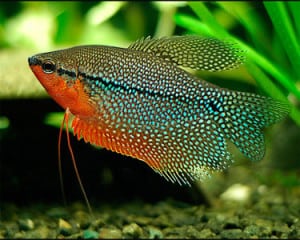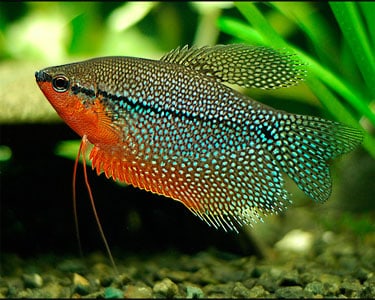
Common name: Pearl Gourami
Scientific name: Trichogaster Leeri
Average Adult Fish Size: 4 inches / 10 cm
Place of Origin: Borneo, Malaysia, Sumatra
Typical Tank setup: Well planted with tall or floating plants shading the surface along with rockwork and bogwood/driftwood.
Recommended Minimum Aquarium Capacity: 30 gallon / 120 litre
Compatibility: The Pearl Gourami are a peaceful community tank fish, but may chase other gourami type fish. Best if kept with fish that are of similar size and temperament, but they can also be kept with smaller schooling type fish, that are too large to be eaten. Males are best kept with 2-3 females.
Temperature: / 73 – 82 Deg F / 23 – 28 Deg C
Water chemistry: pH 6.0 – 8.0
Feeding: Omnivorous and do best on a varied diet of quality flaked and pelleted foods along with brine shrimp, daphnia, brown worms, and blood worms. Live or frozen foods are needed to be fed in order to bring a mature fish into breeding condition.
Sexing: In addition to having differently shaped fins, male and female Pearl Gouramis have slightly different body shapes. Females have more rounded and heavyset bodies. Meanwhile, males are thinner. Male Pearl Gouramis also have more angular bodies, straighter lines instead of curves. This difference is subtle and may take some practice to master. You can readily identify male Pearl Gouramis by their coloration. Males are always more colorful than their female counterparts.
Breeding: This species breeds willingly. They are bubble nest builders and the males build their nests among plants on the surface of the aquarium. Minimizing surface water movement will help maintain the bubble nest. Lowering the water levels and raising the temperature can help trigger spawning. The male guards the nest, the eggs, and fry. Remove the female after spawning. Feed free swimming fry infusoria for 5-7 days and finely crushed flaked food and baby brine shrimp thereafter.
Additional Information: Pearl Gouramis have a lot going for them in the home aquarium. They have intricate patterns and can survive in sub-ideal conditions.


Related Posts
Croaking Gourami – Trichopsis vittatus
Paradise Fish – Macropodus opercularis
Schubert’s Barb – Barbus Semifasciolatus